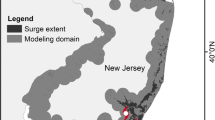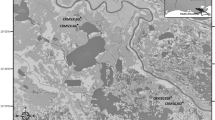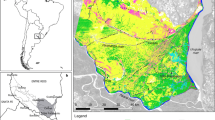Abstract
The spatial scale of habitat selection has become a prominent concept in ecology, but has received less attention in coastal ecology. In coastal marshes, broad-scale marsh types are defined by vegetation composition over thousands of hectares, water-level management is applied over hundreds of hectares, and fine-scale habitat is depicted by tens of meters. Individually, these scales are known to affect wetland fauna, but studies have not examined all three spatial scales simultaneously. We investigated wetland bird habitat selection at the three scales and compared single- and multiscale models. From 2009 to 2011, we surveyed marsh birds (i.e., Rallidae, bitterns, grebes), shorebirds, and wading birds in fresh and intermediate (oligohaline) coastal marsh in Louisiana and Texas, USA. Within each year, six repeated surveys of wintering, resident, and migratory breeding birds were conducted at >100 points (n = 304). The results revealed fine-scale factors, primarily water depth, were consistently better predictors than marsh type or management. However, 10 of 11 species had improved models with the three scales combined. Birds with a linear association with water depth were, correspondingly, most abundant with deeper fresh marsh and permanently impounded water. Conversely, intermediate marsh had a greater abundance of shallow water species, such as king rail Rallus elegans, least bittern Ixobrychus exilis, and sora Porzana carolina. These birds had quadratic relationships with water depth or no relationship. Overall, coastal birds were influenced by multiple scales corresponding with hydrological characteristics. The effects suggest the timing of drawdowns and interannual variability in spring water levels can greatly affect wetland bird abundance.




Similar content being viewed by others
References
Aldridge, C.L., and M.S. Boyce. 2007. Linking occurrence and fitness to persistence: habitat-based approach for endangered greater sage-grouse. Ecological Applications 17: 508–526.
Bancroft, G.T., D.E. Gawlik, and K. Rutchey. 2002. Distribution of wading birds relative to vegetation and water depths in the northern Everglades of Florida, USA. Waterbirds 25: 265–277.
Boers, A., and J. Zedler. 2008. Stabilized water levels and Typha invasiveness. Wetlands 28: 676–685.
Bryant, J.C., and R.H. Chabreck. 1998. Effects of impoundment on vertical accretion of coastal marsh. Estuaries and Coasts 21: 416–422.
Burnham, K.P., and D.R. Anderson. 2002. Model selection and multimodel inference: a practical information-theoretic approach. New York: Springer Science + Business Media, Inc.
Colwell, M.A., and O.W. Taft. 2000. Waterbird communities in managed wetlands of varying water depth. Waterbirds 23: 45–55.
Conway, C.J. 2011. Standardized North American marsh bird monitoring protocol. Waterbirds 34: 319–346.
Conway, C.J., and J.P. Gibbs. 2011. Summary of intrinsic and extrinsic factors affecting detection probability of marsh birds. Wetlands 31: 403–411.
Conway, C.J., and C. Sulzman. 2007. Status and habitat use of the California black rail in the southwestern USA. Wetlands 27: 987–998.
Cooper, T.R. 2008. King rail conservation plan and status assessment. Fort Snelling, MN: U.S. Fish and Wildlife Service.
Costanza, R., S.C. Farber, and J. Maxwell. 1989. Valuation and management of wetland ecosystems. Ecological Economics 1: 335–361.
Costanza, R., F.H. Sklar, and M.L. White. 1990. Modeling coastal landscape dynamics. Bioscience 40: 91–107.
Cowan, J.H., R.E. Turner, and D.R. Cahoon. 1988. Marsh management plans in practice—do they work in coastal Louisiana, USA? Environmental Management 12: 37–53.
Crain, C.M., B.R. Silliman, S.L. Bertness, and M.D. Bertness. 2004. Physical and biotic drivers of plant distribution across estuarine salinity gradients. Ecology 85: 2539–2549.
Darrah, A.J., and D.G. Krementz. 2009. Distribution and habitat use of king rails in the Illinois and Upper Mississippi River Valleys. Journal of Wildlife Management 73: 1380–1386.
ERDAS. 2011. Imagine 11.0. ERDAS, Atlanta, Georgia, USA.
Fitzsimmons, O.N., B.M. Ballard, M.T. Merendino, G.A. Baldassarre, and K.M. Hartke. 2012. Implications of coastal wetland management to nonbreeding waterbirds in Texas. Wetlands 32: 1057–1066.
Fletcher, R.J., and K.E. Sieving. 2010. Social-information use in heterogeneous landscapes: a prospectus. Condor 112: 225–234.
Gabrey, S.W., A.D. Afton, and B.C. Wilson. 2001. Effects of structural marsh management and winter burning on plant and bird communities during summer in the Gulf Coast Chenier Plain. Wildlife Society Bulletin 218–231.
Greenwood, M.D. 2007. Nekton community change along estuarine salinity gradients: can salinity zones be defined? Estuaries and Coasts 30: 537–542.
Guisan, A., and N.E. Zimmermann. 2000. Predictive habitat distribution models in ecology. Ecological Modelling 135: 147–186.
Gunter, G., and W.E. Shell. 1958. A study of an estuarine area with water-level control in the Louisiana marsh. Proceedings of the Louisiana Academy of Sciences 21: 5–34.
Jobin, B., L. Robillard, and C. Latendresse. 2009. Response of a least bittern (Ixobrychus exilis) population to interannual water level fluctuations. Waterbirds 32: 73–80.
King, R.S., A.H. Hines, F.D. Craige, and S. Grap. 2005. Regional, watershed and local correlates of blue crab and bivalve abundances in subestuaries of Chesapeake Bay, USA. Journal of Experimental Marine Biology and Ecology 319: 101–116.
Lotze, H.K., H.S. Lenihan, B.J. Bourque, R.H. Bradbury, R.G. Cooke, M.C. Kay, S.M. Kidwell, M.X. Kirby, C.H. Peterson, and J.B.C. Jackson. 2006. Depletion, degradation, and recovery potential of estuaries and coastal seas. Science 312: 1806–1809.
Manel, S., H.C. Williams, and S.J. Ormerod. 2001. Evaluating presence-absence models in ecology: the need to account for prevalence. Journal of Applied Ecology 38: 921–931.
Meanley, B. 1969. Natural history of the king rail. Account 67 in N. America fauna. Washington DC: Bureau of Sport Fisheries and Wildlife.
Mitchell, L.R., S. Gabrey, P.P. Marra, and R.M. Erwin. 2006. Impacts of marsh management on coastal-marsh bird habitats. Studies in Avian Biology 32: 155.
Mitsch, W.J., and J.G. Gosselink. 2007. Wetlands, 4th ed. Hoboken, NJ: Wiley.
Montague, C.L., A.V. Zale, and H.F. Percival. 1987. Ecological effects of coastal marsh impoundments: a review. Environmental Management 11: 743–756.
Naugle, D.E., K.F. Higgins, S.M. Nusser, and W.C. Johnson. 1999. Scale-dependent habitat use in three species of prairie wetland birds. Landscape Ecology 14: 267–276.
Osland, M.J., N. Enwright, R.H. Day, and T.W. Doyle. 2013. Winter climate change and coastal wetland foundation species: salt marshes vs. mangrove forests in the southeastern United States. Global Change Biology 19: 1482–1494.
Pacheco, C., and P.K. McGregor. 2004. Conservation of the purple gallinule (Porphyrio porphyrio L.) in Portugal: causes of decline, recovery and expansion. Biological Conservation 119: 115–120.
Pearse, A.T., R.M. Kaminski, K.J. Reinecke, and S.J. Dinsmore. 2012. Local and landscape associations between wintering dabbling ducks and wetland complexes in Mississippi. Wetlands 32: 859–869.
Penland, S., and J.R. Suter. 1989. The geomorphology of the Mississippi River Chenier Plain. Marine Geology 90: 231–258.
Pickens, B.A. 2012. Modeling the spatial and temporal dynamics of coastal marsh birds. Ph.D. dissertation, Louisiana State University, Baton Rouge, LA.
Pickens, B.A., and S.L. King. 2012. Predicting the spatial distribution of king rails in an agricultural landscape. Condor 114: 113–122.
Pickens, B.A., and S.L. King. 2013. Microhabitat selection, demography, and correlates with home range size for the king rail (Rallus elegans). Waterbirds 36: 319–329.
Poulin, B., G. Lefebvre, S. Allard, and R. Mathevet. 2009. Reed harvest and summer drawdown enhance bittern habitat in the Camargue. Biological Conservation 142: 689–695.
Rehm, E.M., and G.A. Baldassarre. 2007. The influence of interspersion on marsh bird abundance in New York. Wilson Journal of Ornithology 119: 648–654.
Robel, R.J., J.N. Briggs, A.D. Dayton, and L.C. Hulbert. 1970. Relationships between visual obstruction measurements and weight of grassland vegetation. Journal of Range Management 23: 295–297.
Rogers, D., B. Rogers, and W. Herke. 1994. Structural marsh management effects on coastal fishes and crustaceans. Environmental Management 18: 351–369.
Rota, C.T., R.J. Fletcher Jr., R.M. Dorazio, and M.G. Betts. 2009. Occupancy estimation and the closure assumption. Journal of Applied Ecology 46: 1173–1181.
Rozas, L., and T. Minello. 2010. Nekton density patterns in tidal ponds and adjacent wetlands related to pond size and salinity. Estuaries and Coasts 33: 652–667.
Rush, S.A., E.C. Soehren, M.S. Woodrey, C.L. Graydon, and R.J. Cooper. 2009. Occupancy of select marsh birds within northern Gulf of Mexico tidal marsh: current estimates and projected change. Wetlands 29: 798–808.
Snedden, G.A., and G.D. Steyer. 2012. Predictive occurrence models for coastal wetland plant communities: delineating hydrologic response surfaces with multinomial logistic regression. Estuarine, Coastal and Shelf Science 118: 11–23.
Stedman, S., and T.E. Dahl. 2008. Status and trends of wetlands in the coastal watersheds of the eastern United States 1998 to 2004. National Oceanic and Atmospheric Administration, National Marine Fisheries Service and U.S. Department of the Interior, Fish and Wildlife Service: Washington DC.
Suazo, C.G., A.M. Arriagada, and J.R. Rau. 2012. Ephemeral aquatic bird assemblages in estuarine wetlands from south-central Chile: using an intertidal flat habitat during the austral summer. Estuaries and Coasts 35: 1137–1143.
Swets, J.A. 1988. Measuring the accuracy of diagnostic systems. Science 240: 1285–1293.
Thogmartin, W.E., M.G. Knutson, and J.R. Sauer. 2006. Predicting regional abundance of rare grassland birds with a hierarchical spatial count model. Condor 108: 25–46.
Tozer, D.C., E. Nol, and K.F. Abraham. 2010. Effects of local and landscape-scale habitat variables on abundance and reproductive success of wetland birds. Wetlands Ecology and Management 18: 679–693.
Traill, L.W., K. Perhans, C.E. Lovelock, A. Prohaska, S. McFallan, J.R. Rhodes, and K.A. Wilson. 2011. Managing for change: wetland transitions under sea-level rise and outcomes for threatened species. Diversity and Distributions 17: 1225–1233.
Visser, J.M., C.E. Sasser, R.G. Linscombe, and R.H. Chabreck. 2000. Marsh vegetation types of the Chenier Plain, Louisiana, USA. Estuaries 23: 318–327.
Ward, M.P., T.J. Benson, B. Semel, and J.R. Herkert. 2010. The use of social cues in habitat selection by wetland birds. Condor 112: 245–251.
Webb, E.B., L.M. Smith, M.P. Vrtiska, and T.G. Lagrange. 2010. Effects of local and landscape variables on wetland bird habitat use during migration through the Rainwater Basin. The Journal of Wildlife Management 74: 109–119.
Weller, M.W., and C.S. Spatcher. 1965. Role of habitat in the distribution and abundance of marsh birds. Agricultural and Home Experiment Station Special Report 43, Iowa State University: Ames, Iowa.
Wiens, J.A. 1989. Spatial scaling in ecology. Functional Ecology 3: 385–397.
Yee, T.W., and N.D. Mitchell. 1991. Generalized additive models in plant ecology. Journal of Vegetation Science 2: 587–602.
Acknowledgments
Funding was provided by the US Geological Survey/US Fish and Wildlife Service with support from Gulf Coast Joint Venture. We are grateful for the advice of M. Kaller, P. Stouffer, and F. Rohwer. T. Cooper (USFWS) and two anonymous reviewers provided useful comments on the manuscript. Texas Parks and Wildlife, Louisiana Department of Wildlife and Fisheries, and the US Fish and Wildlife Service provided housing, logistical support, and personnel time. For field assistance, we thank K. Leuenberger, A. Bevill, C. Faller, M. Oliver, M. Huber, E. Dancer, and S. Sears. Any use of trade, firm, or product names is for descriptive purposes only and does not imply endorsement by the US Government. This study was conducted under the auspices of Louisiana State University protocol AE2009-09.
Author information
Authors and Affiliations
Corresponding author
Additional information
Communicated by Bob Christian
Electronic Supplementary Material
Below is the link to the electronic supplementary material.
ESM 1
(PDF 84 kb)
Rights and permissions
About this article
Cite this article
Pickens, B.A., King, S.L. Multiscale Habitat Selection of Wetland Birds in the Northern Gulf Coast. Estuaries and Coasts 37, 1301–1311 (2014). https://doi.org/10.1007/s12237-013-9757-2
Received:
Revised:
Accepted:
Published:
Issue Date:
DOI: https://doi.org/10.1007/s12237-013-9757-2




